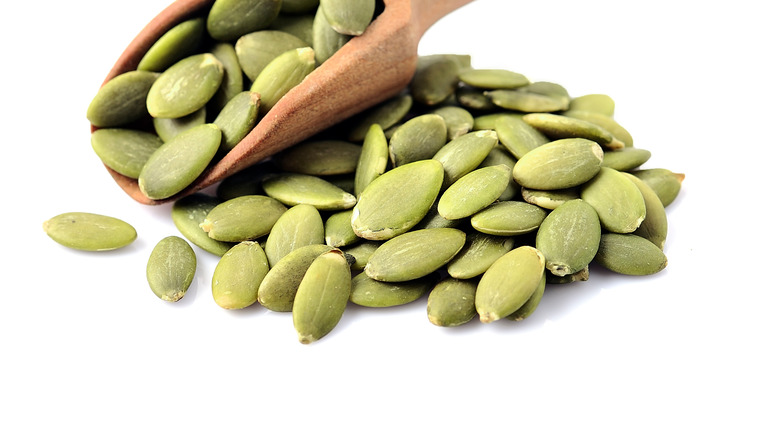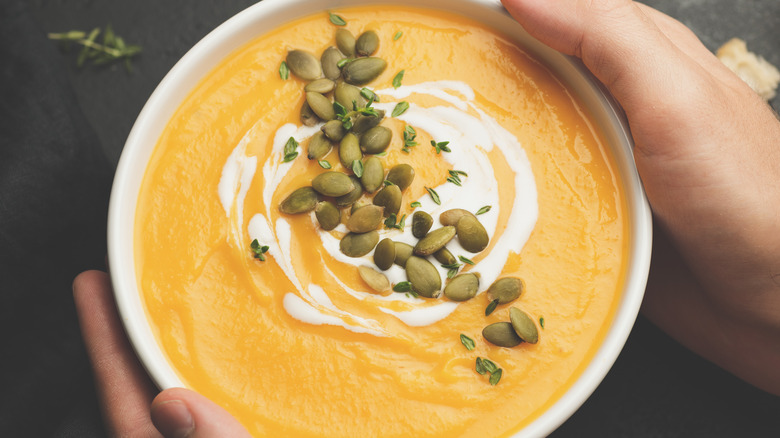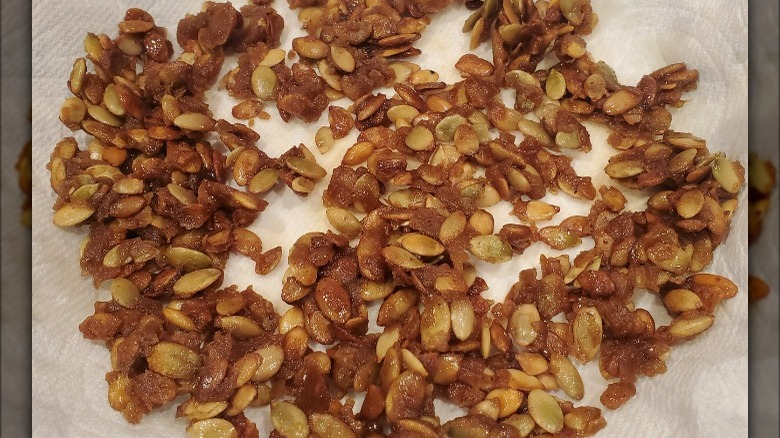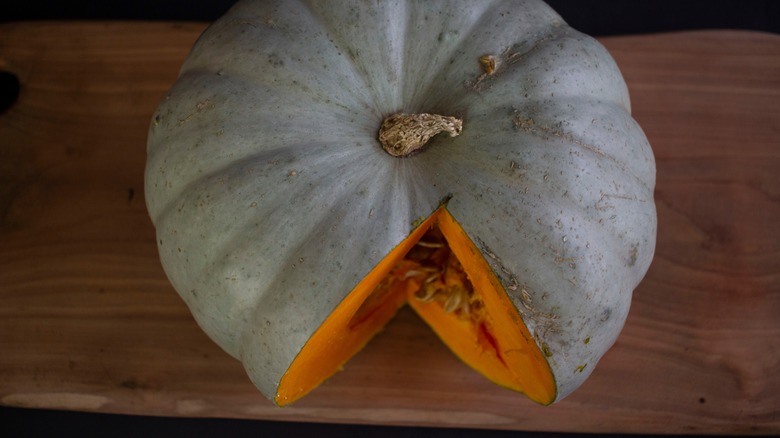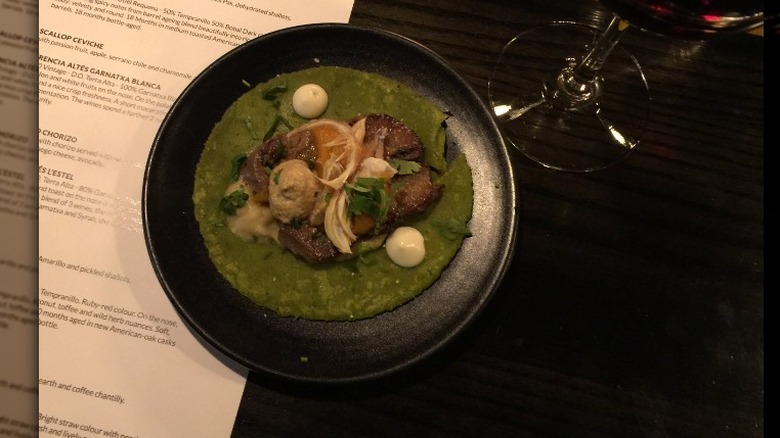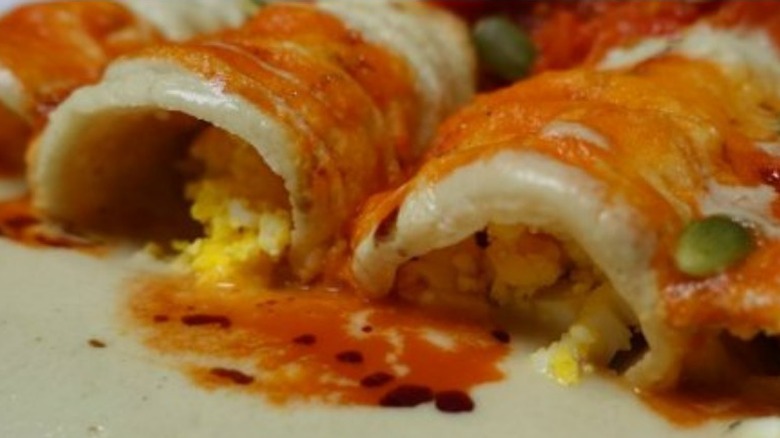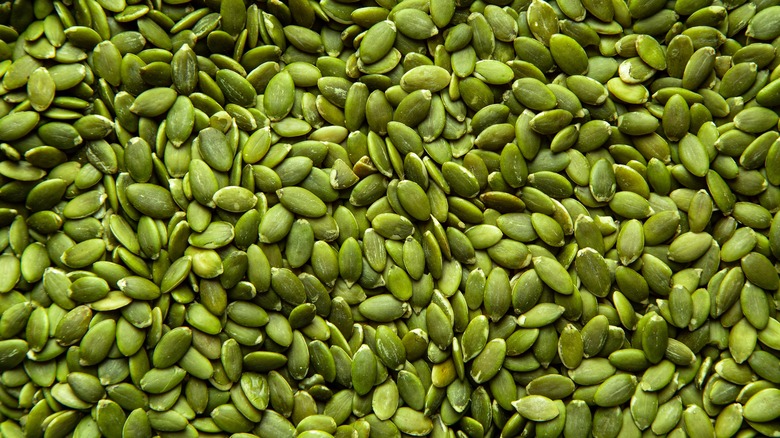The Untold Truth Of Pepitas
You can include many toppings in a fresh salad, some of which add an extra crunch and earthy or salty flavor to the dish. To elevate any meal, you can top it with cashews, sunflower seeds, and so on, but pepitas are some seeds you'd want to sprinkle onto your summer salads, per Taste of Home. You may see pepitas next to the other nuts and seeds at the grocery store and wonder just what these seeds really are and if they're any good for you. Are they the same thing as pumpkin seeds? Do they taste different, and if so, what do they taste like? And most importantly: do pepitas actually taste good?
Fortunately for you, we will answer all your questions. The small, green seeds can often be found combined with store-bought and homemade trail mixes, salads, and other dishes that call for some seeds to liven it up. They can also be eaten on their own as a nice, toasted snack. If you've never had pepitas before, you're missing out on great food, so you might want to change that. In this article, we'll dive into the lesser-known facts about pepita seeds, and when you come out, you'll know a little more about these earthy green delicacies.
Pepitas are not the same as pumpkin seeds
A common misconception that many have regarding the pepita seed is that they are essentially just pumpkin seeds that have had their skin removed. However, the reality is a little more complex, though just as delicious. Pepitas are pumpkin seeds in a way, but they're a bit more than that. The first thing to note is that pepitas, while they come from these vegetables, only come from particular kinds of pumpkins that don't have a hull, Parade notes. That means that while you can get seeds from most pumpkins, you can only get pepita seeds from a few of the festive winter squash.
Another difference is that pepitas don't have the layer of skin covering that pumpkin seeds have. You can peel the skin off pumpkin seeds to get some pepita yourself as some pumpkins naturally contain the pepita seeds, such as the Lady Godiva, and the Kakai Hulless, which you can easily grow on your own (as per The Cooking). However, if you don't have a green thumb or the time to peel the skin off of your pumpkin seeds, you're in luck because pepitas are also easy to find in grocery stores. So, before you purchase them, make sure you're grabbing the skinless green pepitas and not pumpkin seeds.
They're healthy to eat if you're pregnant
When you're having a baby, you want to ensure everything goes as perfectly as possible. This requires a lot of prep, well before the baby's actual due date. One of the most important things a mother can do for the child is to keep herself in good health and do her best to eat well to ensure that the baby comes out healthy (via Health Gov). Many soon-to-be parents may stress and worry about what foods they should and shouldn't be eating to make sure their baby is getting all the nutrients they need and may wonder if their favorite foods are something they have to cut back on.
Fortunately for all expecting parents out there, it is not just okay to eat pepitas, but it's great to consume them during pregnancy. According to The 100 Healthiest Foods to Eat During Pregnancy by Jonny Bowden and Allison Tannis, pepitas are one of the best foods to eat when pregnant, as they are filled with iron, magnesium, and loads of other trace minerals. They're perfectly healthy to eat and a great way to ensure that your baby gets enough nutrients. Furthermore, the book notes that the seeds contain omega-3 fatty acids, which are crucial in the development of a fetus's brain and eyes. So if pepitas are a favorite in your household, you don't need to worry because they are perfectly healthy to consume — even when you're pregnant.
You can make candies with the seeds
Pepitas are commonly found as an ingredient in trail mixes, a topping on salads, or in other delicious meals that call for a toasted seed, My Southern Health notes. Even as a snack on its own, pepitas are salted and tend to lean towards the more savory side of flavors. However, they can and are often used for sweeter things, whether you choose to mix it into a dessert or use it as a topping. With the earthy, salty nature the seed has, pepitas pair with the sugary ingredients of super sweet desserts wonderfully and typically result in the creation of a harmonious, hearty treat.
There are loads of desserts you can make with pepita seeds, such as our very own copycat Starbucks pumpkin bread, which is sweet, spicy, and with some pepitas, has a great extra crunch and adds to the taste by giving it a nice nutty flavor. Celebrity chefs also make desserts with pepita seeds. There are loads you can do with these seeds, so don't just limit yourself to the savory side of things.
They were probably eaten during the age of the Mayans
Ever since civilization first began to experiment with agriculture somewhere around 10,000 B.C. (via History), seeds, grains, and nuts have been grown and consumed. They've been around longer than some of the staple foods we know and love today (per Nutcracker Museum) and are still just as widely consumed on bread and snacks. Pepitas, in particular, have also been around for a long time, since pumpkins were first planted and grown in the east thousands of years ago, GBH notes. Specifically, in Mexico, pepitas were and still are an important part of their culture and history.
According to the BBC, "calabaza" is a word for pumpkin or squash. These were the original pumpkins, which tasted a little more bitter than the vegetable we consume today. The calabaza has been consumed since the era of the ancient Mayan empire and was even enjoyed by the Aztecs, Nutstop says. While some civilizations only used a few vegetables, it was common practice in the Mexican area for almost every part of the squash or pumpkin — including the pepita seeds — to be prepared, harvested, and eaten. Nowadays, pepitas are still a staple in Mexican culture and foods, and are thrown onto a grill, salted, enjoyed as a snack, or used in meals.
Pepitas may help you get to sleep
Even after a long, eventful day of work or fun, some may find it difficult to relax and turn in for the night. If this is a frequent occurrence for you, you may find yourself turning to foods and supplements that aid in sleep support, like teas, medicines, or even a classic glass of milk. Of course, there are some foods that you should avoid eating right before you sleep, but there are also many things that you should consume to help you fall asleep faster and get a good night's rest. Believe it or not, pepitas are one of those foods.
According to WebMD, L-Tryptophan is an amino acid that can help someone fall asleep and is commonly found in red meats and poultry, as well as eggs and dairy. Surprisingly, Healthy And Natural World claim that pepitas also contain some L-Tryptophan; by extension, the green seeds can help you in your efforts to get a better night's rest. So while the pairing of milk and cookies is the most well-known snack to have before bed during our childhoods, a warm cup of milk and a handful of pepita seeds may actually be the best way to go for a healthy, rest-filled night.
You can use them to make the next hummus dip
There are loads of different dips and salsas you can make to add an extra kick of flavor to your chips, crackers, or vegetables. Hummus, a chickpea and tahini-based paste that is frequently spread on crackers and pita chips to make for a flavorful and delicious snack, is one of these dips. Of course, if you're looking for something sweeter, there's chocolate hummus, too. All in all, hummus is a wonderful spread, loved by many, and with guacamole and salsa, your kitchen is pretty much set in terms of delicious dips — or is it?
Pepitas are used to make incredible chip and cracker dips, including sikil pak. This dish is a Mayan pumpkin seed spread made with pepitas, tomatoes, orange juice, onions, coriander, and habanero chili pepper (via Taste Atlas). It makes for a delicious spicy dip, perfect for any chip or cracker you so choose. It's also becoming steadily popular, as well, with SmartBrief placing this dish on a list of foods that people should keep their eyes peeled for this year. It may not be hummus, but if you're ever invited to a party, bringing a homemade or store-bought pepita dip is something that will definitely make heads turn.
It's common to find pepitas on Mexican dishes
We've already established that pepitas have been eaten ever since the Aztec and Mayan civilizations were around, so it should be no surprise that many Mexican dishes feature them as a prevalent ingredient. The roasted, salty nature of many prepared servings of pepita seeds adds an extra crunch and salt flavor to anything they're included in. According to Mexican News Daily, they are a secret ingredient to be added to pipián verde or a green Mexican mole, which can be served with tacos, meat dishes, or just as a dip.
The sauces that pepitas are commonly used to make, such as sikil pak and papián verde, are used to top many a Mexican dish, including Dzotobichay, a Yucatecan tamal made from chaya, a type of spinach, and egg (via Yucatan Today). The addition of the pepita paste provides an additional spicy flavor to this plate, along with other cultural dishes, like Papadzules. Papadzules is another Yucatán dish that's a lot like an enchilada and is made with corn tortillas. This makes them the perfect thing to add a hearty pepita mole or paste to, and dinners consisting of these dishes are usually dipped into a roasted pepita sauce.
Pepitas have loads of other health benefits
Roasted pepitas or pepitas of any kind don't just taste good — they're also quite healthy for you. First of all, they are loaded with magnesium and other minerals crucial to one's health, as well as vitamin E (via ScienceDirect). These all contribute to different aspects of somebody's health, with each mineral assisting with something like bone and skin health, as well as energy production. That alone makes pepitas a healthy snack to add to your diet and get your fill of vital nutrients in a tasty way.
Pepitas don't just contain a few minerals, however. A diet of these delicious seeds can also help lower blood sugar, thanks to the magnesium content within a serving of these seeds (via Healthline). Furthermore, Healthline notes that pepitas may assist in reducing the risks of certain cancers, as a supplement with pumpkin seeds in it possibly assisted in slowing down prostate cancer cells growth. They also contain phytoestrogen, which may be related to reducing certain hormone-dependent tumors (via IJCC). In general, these seeds are very healthy for you, and they're easy to just sprinkle on top of a salad or have as a snack, so you may want to consider adding them to your next meal plan.
Pati Jinich and other chefs love to use pepitas
Pepitas are found in many dishes, so there's no doubt they're a delicious addition to any meal. There are many chefs out there who agree with this sentiment and even swear by the use of pepitas in some of their recipes. One of these chefs is Martha Stewart, who uses the seeds to make candied pepitas, which she uses as a topping for a classic pumpkin pie — though we reckon you could use some of these pepitas to top a couple of scoops of fresh vanilla ice cream, as well (via Martha Stewart). Another celebrity chef who cooks and bakes with the seeds is Ryan Rondeno, who uses pepitas in some of his fall-themed recipes, New Scene notes.
Pati Jinich is yet another chef who's known for her delicious Mexican dishes — some of which include pepitas. In fact, she has an entire blog page dedicated to describing these seeds and how she would frequently stuff them in her suitcase when she visited Mexico (via Pati Jinich). She described the seeds as mellow and nutty, as well as a healthy, delicious addition to many of her dishes, providing a subtle, crunch, and salted flavor to just about everything they're added to. So even if you aren't a professional chef yourself, nothing is stopping you from trying to add some pepitas to your own dinners, and in doing so, you'll be in for a delicious, crunchy surprise.
